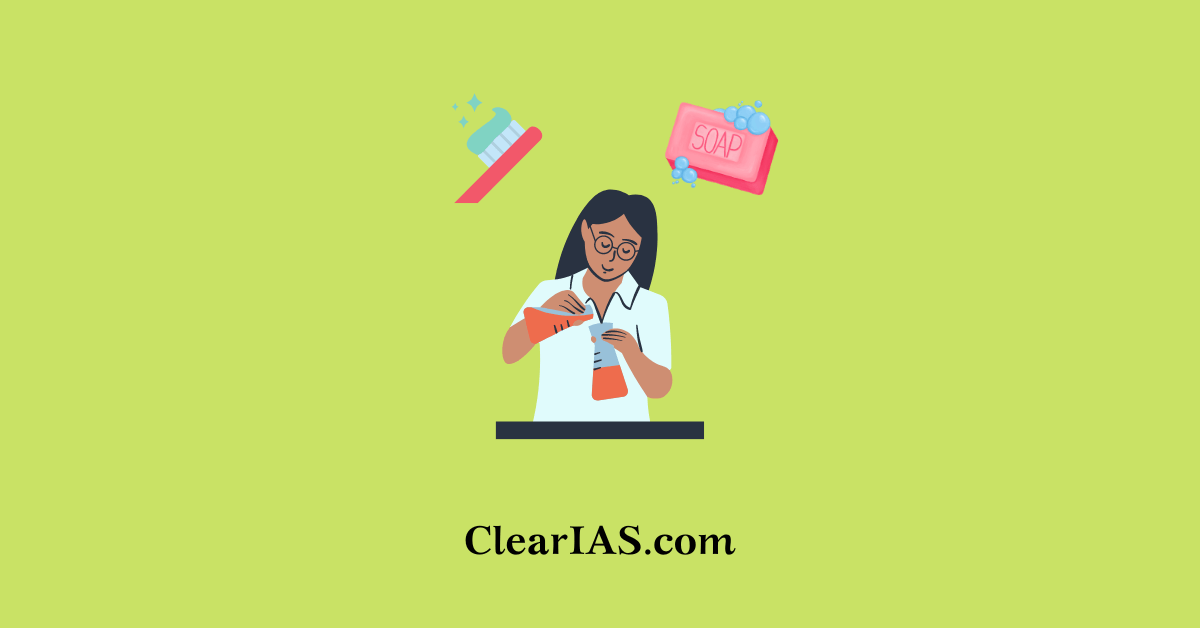 Can you imagine a day without bathing having food or wearing a dress? The materials we use like soaps, sprays, cosmetics, detergents, toothpaste, etc, are composed of several chemicals. Because of how much chemistry has impacted our lives, we are constantly exposed to chemicals without even realizing them. Read here to learn more about chemicals in everyday life.
Can you imagine a day without bathing having food or wearing a dress? The materials we use like soaps, sprays, cosmetics, detergents, toothpaste, etc, are composed of several chemicals. Because of how much chemistry has impacted our lives, we are constantly exposed to chemicals without even realizing them. Read here to learn more about chemicals in everyday life.
Chemicals govern all of our behaviors, and we are amazing chemical creatures. Humanity has benefited from the usage of chemistry principles.
Illness and disease make us think of medications, which are yet another chemical. Chemicals are used in everything from explosives to fuel to rocket propulsion to building and electronic materials.
Let’s see the various applications of chemicals in everyday life.
Read: Click chemistry
Food
Chemicals are the basic building blocks of everything. All food is made of chemical compounds, including carbohydrates, vitamins, fats, proteins, and fiber, all of which are safe and frequently seen as desirable.
Chemicals have a significant role in the production and storage of food. Chemicals used in food preservation have greatly benefited in keeping food fresher for longer. Meals can be made better and more filling by using cans of food additives, flavorings, and nutritional supplements.
Some examples are as follows:
- Artificial Sweetening Agents – Since sucrose increases calorie consumption, many people choose to use artificial sweeteners instead. Saccharin, also known as ortho-sulphobenzimide, was the first widely used artificial sweetening ingredient. Since it was discovered in 1879, it has been employed as a sweetening agent. It has 550 times the sweetness of cane sugar. It is eliminated from the body unchanged through the urine. When consumed, it seems completely safe and inert. Its use is very beneficial for diabetics and others who must limit their calorie intake. Some other commonly marketed artificial sweeteners are Sucralose, Aspartame, and Alitame.
- Food preservatives – Food preservation agents stop microbial growth from causing food to spoil. The most often used preservatives are sodium benzoate (C6H5COONa), sugar, vegetable oils, and table salt. In small doses, sodium benzoate is used; it is also metabolised by the body. As preservatives, sorbic acid and propanoic acid salts are also employed.
- Antioxidants – These stop food from oxidising, which stops food from going bad. For example, butylated hydroxyl anisole and butylated hydroxyl tolerance (BHA).
Cleansing Agents
Cleaning agents are things we use to remove dirt, dust, bad odours, stains, and other things from surfaces. These are the substances we employ to lessen surface tension so that water can function exactly as intended. Cleaning with just water is ineffective because the surface tension prevents cohesive forces from operating.
Soaps and detergents are two chemicals in everyday life we use frequently.
Related topics: Agrochemicals
Soaps
The process of making soap often involves combining a liquid alkali (such as sodium hydroxide) with naturally occurring fats or fatty acids derived from plants and animals. The action is referred to as saponification.
Surfactants, or surface active agents, are present in soaps. They essentially lessen the water’s surface tension. Surfactants enable the water to moisten the surface by attaching to the water molecules at one end. Surfactants attach to oils and dirt at the other end. Overall, they enable the water to clean the surface more effectively.
Detergents
Synthetic detergents are the other category of cleaning agents. These items have all the characteristics of soap, making them exactly like soap. However, they are completely unrelated to soaps chemically and do not contain any soap at all.
Detergents have many advantages over soaps, one of which is their versatility. Both soft and hard water are compatible with them. In hard water, they don’t produce any scum. Some detergents can even function in water that is ice cold.
Medicines and Health Care
- Pharmaceuticals: From aspirin (acetylsalicylic acid) to more complex molecules, chemicals in medicines treat, manage, and prevent diseases. The development of these compounds is a critical area of scientific research and has dramatically improved life expectancy and quality of life.
- Vaccines: Chemical adjuvants in vaccines enhance the body’s immune response to the vaccine, making them more effective in preventing diseases.
Clothing
- Synthetic Fibers: Chemicals are the building blocks of synthetic fibers like polyester, nylon, and acrylic, which are staples in the fashion industry due to their durability and versatility.
- Dyes and Finishes: Chemical dyes give clothes their colors, while other chemical treatments can provide additional properties such as water resistance or reduced wrinkling.
Technology and Entertainment
- Batteries: Chemicals in batteries, such as lithium ions in lithium-ion batteries, provide the power for everything from smartphones to electric cars.
- Plastics: Derived from petrochemicals, plastics are found in countless products, including electronics, toys, and household items. While versatile and economical, the environmental impact of plastics is a significant concern.
Construction and Home Maintenance
- Paints and Coatings: Chemical compounds in paints and coatings protect surfaces and improve aesthetics. Innovations include low-VOC (volatile organic compounds) paints that reduce harmful emissions.
- Insulation: Chemical-based materials like polystyrene and polyurethane foam are widely used for thermal insulation in buildings.
Let’s see some of the chemicals in everyday life:
Common Name/Product |
Chemical |
Use/Property of the Chemical |
Food Preservatives |
Sulphites, Nitrites, Benzoates |
These are the chemical classes that are most frequently employed as food preservatives. They prolong the shelf life of grains and food items and prevent the formation of microorganisms. |
Detergent |
Sodium sulphate, Sodium hydroxide, and Phosphate compounds |
These are cleansing surfactants that become active when they are diluted. They are surface-cleaning foaming agents that can combine with water to hold oil and debris. |
Dyes and Cosmetics |
Esters |
It belong to a group of organic substances that react with water to create alcohol and acids (organic or inorganic). These are utilised in medicinal, cosmetic, and colouring products . |
Baking Powder |
NaHCO3: Sodium bicarbonate (and one or more weak acid) |
It is a leavening or raising agent used in cookery to give baked goods more volume and a lighter texture. An acid-base reaction, causes the batter to generate carbon dioxide. |
Toothpaste |
Calcium carbonate and Sodium fluoride |
Used for cleaning teeth and maintaining oral health. |
Common Salt |
NaCl |
The table salt that we use for seasoning and cooking. Additionally, it is an excellent food preservative. |
Sugar |
C12H22O11 |
Sugar is used as a sweetener for edibles. |
Bleach |
NaOCl |
Utilised as household bleach for cleaning. It is a powerful anti-microbial and disinfectant. Additionally, it is applied to clothing as a bleaching agent. |
Vinegar |
C2H4O2: acetic acid, ethanoic acid |
Commonly used in homes as a seasoning and preservative. For some surfaces, it is also employed as a household cleaning agent. |
Graphite |
Carbon |
It is an allotrope of carbon that is most widely found as pencil lead. In addition to several additional residential and industrial uses, it is a crucial component of the batteries we use for a variety of functions. |
Aspirin |
C9H8O4: acetylsalicylic acid |
Aspirin is most frequently used in over-the-counter medications for pain, inflammation, and fever. |
Epsom salt |
MgSO₄: Magnesium sulfate |
To calm the body and ease muscle tension, it is used as a bath salt. |
Hydrogen Peroxide |
H2O2 |
There are various industrial uses for hydrogen peroxide. Hydrogen peroxide is a substance that is utilised in personal hygiene products for home usage. Additionally, it is used to bleach hair and treat acne.
. |
Toilet Cleaner |
HCl: Hydrochloric acid |
It is a widely popular acid that is used as a cleaning agent, particularly in bathrooms and toilets. |
Caustic Soda |
NaOH: Sodium hydroxide |
Since caustic soda is a very corrosive alkali, it is used to unclog sinks, toilets, and drains. |
Mothballs |
C6H4C12 |
It is a chemical that smells strongly stinky. It is used to protect clothing and materials from fabric bugs and clothes moths |
Hand Sanitizer |
Isopropyl alcohol |
A chemical that kills germs and bacteria from our hands and saves us from many diseases. |
Insect Repellent (to be applied on the skin) |
Diethyltoluamide |
Keeps us safe from bug bites, most commonly mosquito bites. |
Rodent and Pests Killer |
Arsenic |
Arsenic is a poisonous chemical that is used to wipe off rats, cockroaches, and such pests in our homes. |
Deodorants / Anti-perspirant |
Aluminum chlorohydrate |
It is a substance that is used to regulate sweating and stop body odour. |
Chalk |
CaCO3 |
Used for writing on blackboards. |
MSG |
C₅H₈NO₄Na: Monosodium glutamate |
This name can be seen on the label of any packaged food that is ready to eat or prepare quickly. This substance is intended to improve flavour and leave you wanting more. |
Environmental and Health Considerations
While chemicals in everyday life are indispensable in modern life, their production, use, and disposal come with environmental and health considerations.
- Issues such as pollution, chemical toxicity, and the accumulation of non-biodegradable substances in the environment have prompted increased regulation and a push towards greener alternatives.
- Sustainable chemistry and the development of bio-based or less harmful substitutes are growing fields aimed at minimizing the negative impacts of chemicals on health and the environment.
In conclusion, chemicals are integral to daily life, providing numerous benefits across a wide range of applications. However, their pervasive use also necessitates a careful balance between enjoying their advantages and addressing the environmental and health challenges they pose.
Also read: Spurious liquor: Hooch tragedies in India
Article written by: Krishnapriya JR






Leave a Reply